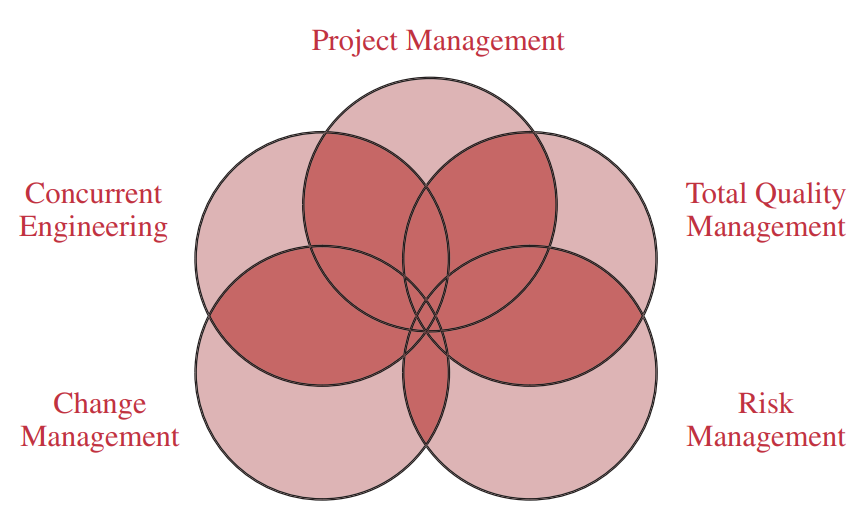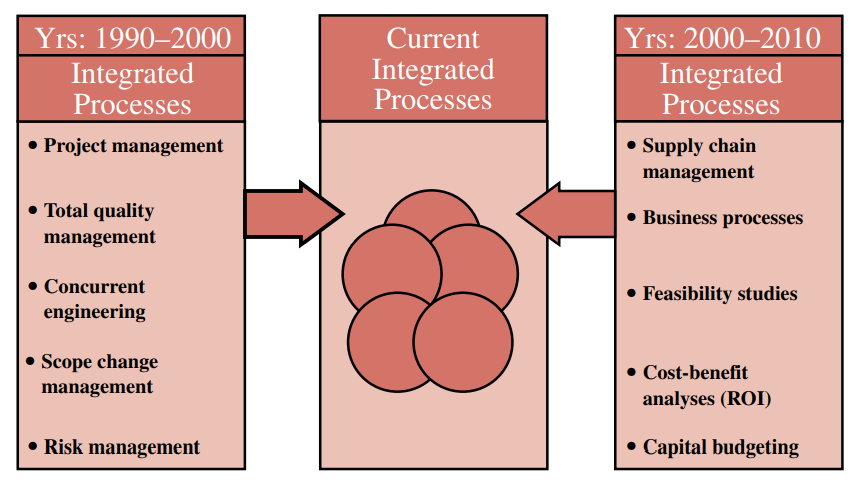Achieving project management excellence, or maturity, is more likely with a repetitive process that can be used on each and every project. This repetitive process is referred to as the project management methodology.
If possible, companies should maintain and support a single methodology for project management. Good methodologies integrate other processes into the project management methodology, as shown in Figure 2–24. Companies such as Nortel, Ericsson, and Johnson Controls Automotive have all five of these processes integrated into their project management methodology.
During the 1990s, the following processes were integrated into a single methodology:
● Project Management: The basic principles of planning, scheduling, and controlling work
● Total Quality Management: The process of ensuring that the end result will meet the quality expectations of the customer
● Concurrent Engineering: The process of performing work in parallel rather than series in order to compress the schedule without incurring serious risks
● Scope Change Control: The process of controlling the configuration of the end result such that value added is provided to the customer
● Risk Management: The process of identifying, quantifying, and responding to the risks of the project without any material impact on the project’s objectives
In the coming years, companies can be expected to integrate more of their business processes in the project management methodology. This is shown in Figure 2–25.


Managing off of a single methodology lowers cost, reduces resource requirements for support, minimizes paperwork, and eliminates duplicated efforts.
The characteristics of a good methodology based upon integrated processes include:
● A recommended level of detail
● Use of templates
● Standardized planning, scheduling, and cost control techniques
● Standardized reporting format for both in-house and customer use
● Flexibility for application to all projects
● Flexibility for rapid improvements
● Easy for the customer to understand and follow
● Readily accepted and used throughout the entire company
● Use of standardized life-cycle phases (which can overlap) and end of phase reviews (Section 2.13)
● Based upon guidelines rather than policies and procedures (Section 2.9)
● Based upon a good work ethic
Methodologies do not manage projects; people do. It is the corporate culture that executes the methodology. Senior management must create a corporate culture that supports project management and demonstrates faith in the methodology. If this is done successfully, then the following benefits can be expected:
● Faster “time to market” through better control of the project’s scope
● Lower overall project risk
● Better decision-making process
● Greater customer satisfaction, which leads to increased business
● More time available for value-added efforts, rather than internal politics and internal competition
One company found that its customers liked its methodology so much and that the projects
were so successful, that the relationship between the contractor and the customer improved
to the point where the customers began treating the contractor as a partner rather than as a
supplier.
Source : Project management A system approach to planning, scheduling and controlling [EIGHTH EDITION] By HAROLD KERZNER, Ph.D.
